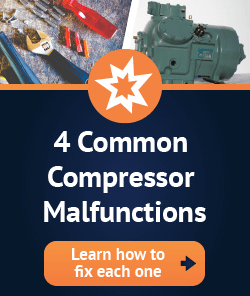
Bearing vibration is an indication of parts wearing down over time. HVAC maintenance technicians use vibration tests to determine signs of wear and plan a proper maintenance course for the future. With this guide, you should be able to identify early signs of bearing vibration so you can call in an expert to run a full diagnostic test. Here’s what that process looks like for you:
Early Signs of Vibration
Bearings that are starting to wear down will produce a number of changes in the performance of your commercial HVAC compressor. While it may be hard to trace, a loss of efficiency will occur as the bearings no longer provide the guidance that they are meant to have within the rotating bodies. In addition, as they wear down, small gaps appear between inner and outer sections, which will cause rattling and eventually a more pronounced vibration as the bearings get further and further out of balance.
Conducting a Vibration Test
If you suspect that your commercial compressor is developing a more serious vibration, there are test instruments available to help you diagnose the problem. First, you need to know that there are several different kinds of vibration tests available. Some of these tests you can do on your own using equipment that is readily available from HVAC suppliers. Other tests require a test booth and are not designed for use in the field.
The simplest test you can do is called a Broadband Vibration test, or an Overall Vibration Test. This is done with the help of a tri-axial accelerometer, a common tool that is easy to use. This little cluster instrument uses three accelerometers mounted around a circle to pick up variations in vibration at different locations, speeds, and frequencies. Your compressor will have a mounting slot designed for use with this tool. Simply line up the slot with the hole on the accelerometer cluster and mount it firmly in place. Then, turn on your compressor and allow it to ramp up to full operational speed. The instrument will measure the data and record it, sending it to a computer or other reader so that you can see the graphs of where the vibration is occurring.
You will use the graph to compare your results to that of a healthy compressor. You will see that certain areas show a spike in vibration, usually correlated with a specific frequency range on your compressor.
Interpreting Your Results
Unless you are an expert in commercial HVAC compressors, these results alone may not be meaningful to you. You will likely need to call in a specialist who can look at the results and perform some additional testing. A broadband vibration test is an affordable and easy way for you to test your compressor if you are starting to notice a change in performance. Further testing will allow a technician to focus on the hot spots where additional vibration is occurring and determine the extent of the damage. These tests will give you a relative lifeline on your bearings so you can plan ahead for replacements or repairs whenever possible. Unfortunately, these tests alone are not sufficient to determine the root cause of bearing wear if it is an ongoing problem. In these cases, more in-depth testing will be done.
If you find that you have serious bearing problems, it may be time to plan for a remanufactured or new compressor to keep things running smoothly. If so, please contact Compressors Unlimited today.












